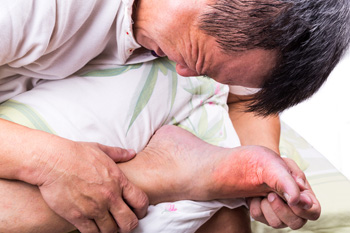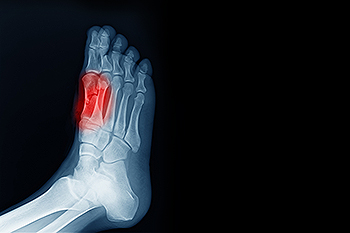

The foot condition that is known as Sever’s disease can affect children and young teenagers who participate in running and jumping activities. It is considered to be an ailment that comes from overuse in and around the growth plate in the heel. The child may complain of having heel pain, and can have difficulty in walking. A podiatrist can perform a proper diagnosis, which consists of having a physical examination done, in addition to learning about the child's choice of activities. The child will eventually outgrow Sever’s disease, and until then, mild relief can be found when the activity that caused this condition is temporarily stopped. Patients may also find that it helps to elevate the affected foot as often as possible, and it may be beneficial to wear a heel pad in the shoe. It is strongly suggested that your child sees a podiatrist at the first sign of heel pain, so a proper diagnosis can be performed, and the correct treatment can promptly begin.
Sever's disease often occurs in children and teens. If your child is experiencing foot or ankle pain, see Massimo Pietrantoni, DPM from Rochester Podiatry, LLP. Our doctor can treat your child’s foot and ankle needs.
Sever’s Disease
Sever’s disease is also known as calcaneal apophysitis, which is a medical condition that causes heel pain I none or both feet. The disease is known to affect children between the ages of 8 and 14.
Sever’s disease occurs when part of the child’s heel known as the growth plate (calcaneal epiphysis) is attached to the Achilles tendon. This area can suffer injury when the muscles and tendons of the growing foot do not keep pace with bone growth. Therefore, the constant pain which one experiences at the back of the heel will make the child unable to put any weight on the heel. The child is then forced to walk on their toes.
Symptoms
Acute pain – Pain associated with Sever’s disease is usually felt in the heel when the child engages in physical activity such as walking, jumping and or running.
Highly active – Children who are very active are among the most susceptible in experiencing Sever’s disease, because of the stress and tension placed on their feet.
If you have any questions, please feel free to contact one of our offices located in Brighton and Greece of Rochester, NY . We offer the newest diagnostic and treatment technologies for all your foot and ankle injuries.

Gout is an inflammatory condition that causes redness, swelling, stiffness, and extreme pain in the joints, particularly the big toe. A gout attack in the big toe, termed podagra, happens suddenly and often at night. Sufferers may be jolted awake by pain and a burning sensation so great that even the weight of a sheet on the toe can be agonizing. Gout is more common in men, but the risk factor increases in women after menopause. Gout is caused by a buildup of uric acid in the body, which forms crystals in joints, resulting in severe pain. Attacks usually last for about a week but can occur again without warning. Because the crystals, called tophi, that form in the toe joint can cause both cartilage and bone damage, it is not a good idea to ignore this condition. Instead, if you believe you have developed gout, please make an appointment with a podiatrist who can offer treatment options and suggest lifestyle changes to best combat this disease.
Gout is a painful condition that can be treated. If you are seeking treatment, contact Massimo Pietrantoni, DPM from Rochester Podiatry, LLP. Our doctor will treat your foot and ankle needs.
What Is Gout?
Gout is a form of arthritis that is characterized by sudden, severe attacks of pain, redness, and tenderness in the joints. The condition usually affects the joint at the base of the big toe. A gout attack can occur at any random time, such as the middle of the night while you are asleep.
Symptoms
Risk Factors
Prior to visiting your podiatrist to receive treatment for gout, there are a few things you should do beforehand. If you have gout you should write down your symptoms--including when they started and how often you experience them, important medical information you may have, and any questions you may have. Writing down these three things will help your podiatrist in assessing your specific situation so that he or she may provide the best route of treatment for you.
If you have any questions, please feel free to contact one of our offices located in Brighton and Greece of Rochester, NY . We offer the newest diagnostic and treatment technologies for all your foot care needs.

A condition known as sesamoiditis occurs when tissues that embed the two tiny sesamoid bones just under the base of the big toe become inflamed. Sesamoiditis is considered to be an overuse injury, caused when pressure is repeatedly put on the ball of the foot, especially when flexing the big toe. As a result, this injury is common among runners, football players, dancers and basketball players. Treatments vary for sesamoiditis, and experts find that a combination of them works best. Included are eliminating the activities that cause the overuse, taking pain medication, and performing certain exercises. Wearing shoes that fit properly is recommended, and wearing high-heels or any shoes that force the weight onto the ball of the foot should be avoided. In some cases, depending on the severity of the sesamoiditis, cortisone injections can be effective in reducing the symptoms of pain, swelling, and difficulty bearing weight. Gel and foam orthotics are often used to reduce the pain. To find out more about treating sesamoiditis, please consult a podiatrist.
Sesamoiditis is an unpleasant foot condition characterized by pain in the balls of the feet. If you think you’re struggling with sesamoiditis, contact Massimo Pietrantoni, DPM of Rochester Podiatry, LLP. Our doctor will treat your condition thoroughly and effectively.
Sesamoiditis
Sesamoiditis is a condition of the foot that affects the ball of the foot. It is more common in younger people than it is in older people. It can also occur with people who have begun a new exercise program, since their bodies are adjusting to the new physical regimen. Pain may also be caused by the inflammation of tendons surrounding the bones. It is important to seek treatment in its early stages because if you ignore the pain, this condition can lead to more serious problems such as severe irritation and bone fractures.
Causes of Sesamoiditis
Treatment for sesamoiditis is non-invasive and simple. Doctors may recommend a strict rest period where the patient forgoes most physical activity. This will help give the patient time to heal their feet through limited activity. For serious cases, it is best to speak with your doctor to determine a treatment option that will help your specific needs.
If you have any questions please feel free to contact one of our offices located in Brighton and Greece of Rochester, NY . We offer the newest diagnostic and treatment technologies for all your foot and ankle needs.

There are seven tarsal bones in each foot, and the cuboid bone is one of them. An injury can cause pain on the outside of the foot when the cuboid bone is affected, which can result in cuboid syndrome. Some patients feel pain in the middle of their foot, or on the bottom of the fourth and fifth toes. This condition can occur when the bones in the center of the foot become partially dislocated from gradual overuse, or from a sudden injury. It is a common injury among ballet dancers, as a result of this style of dancing. Patients who have feet that turn inward may have an increased risk of developing cuboid syndrome, in addition to wearing shoes that do not fit correctly. People who run on uneven surfaces may get this condition, and warming up or cooling down inadequately may increase the risk of having cuboid syndrome. Effective treatment begins with temporarily stopping the activity that caused the condition, and frequently elevating the affected foot may reduce the swelling. If you have this ailment, please consult with a podiatrist who can accurately diagnose and treat cuboid syndrome.
Cuboid syndrome, also known as cuboid subluxation, occurs when the joints and ligaments near the cuboid bone in the foot become torn. If you have cuboid syndrome, consult with Massimo Pietrantoni, DPM from Rochester Podiatry, LLP. Our doctor will assess your condition and provide you with quality foot and ankle treatment.
Cuboid syndrome is a common cause of lateral foot pain, which is pain on the outside of the foot. The condition may happen suddenly due to an ankle sprain, or it may develop slowly overtime from repetitive tension through the bone and surrounding structures.
Causes
The most common causes of cuboid syndrome include:
Symptoms
A common symptom of cuboid syndrome is pain along the outside of the foot which can be felt in the ankle and toes. This pain may create walking difficulties and may cause those with the condition to walk with a limp.
Diagnosis
Diagnosis of cuboid syndrome is often difficult, and it is often misdiagnosed. X-rays, MRIs and CT scans often fail to properly show the cuboid subluxation. Although there isn’t a specific test used to diagnose cuboid syndrome, your podiatrist will usually check if pain is felt while pressing firmly on the cuboid bone of your foot.
Treatment
Just as the range of causes varies widely, so do treatments. Some more common treatments are ice therapy, rest, exercise, taping, and orthotics.
If you have any questions, please feel free to contact one of our offices located in Brighton and Greece of Rochester, NY . We offer the newest diagnostic and treatment technologies for all your foot care needs.